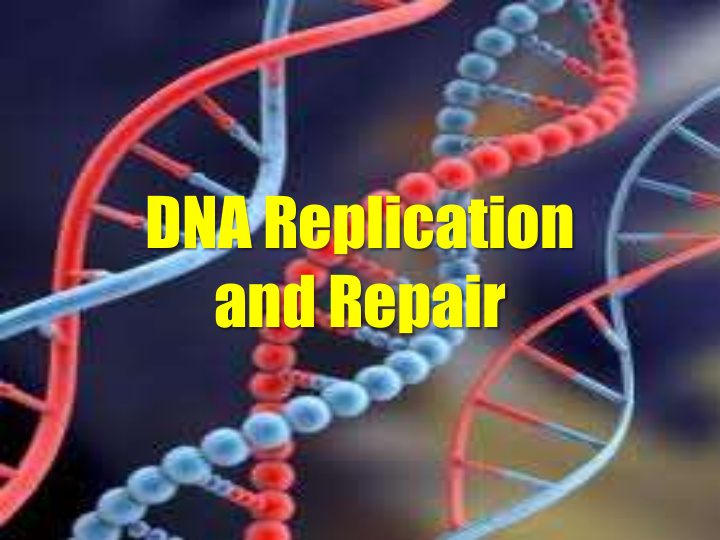



DNA Replication and Repair
http://hyperphysics.phy-astr.gsu.edu/hbase/organic/imgorg/cendog.gif
• genetic information is passed on DNA to the next generation Replication • semi-conservative T A T T A T A A A T A T G C G G C C G C C G C G A T A A T A T T A T A T T T A T T A A A T A T A G C C C G C G G C G C G Each daughter Parent molecule Parental Each parental DNA molecule with two strands strand is a consists of one complementary parental and one separate template molecules new strand
Overview of replication Initiation • DNA is unwound and stabilized • Origins of replication: Replication bubble and replication fork Priming • RNA primers bind to sections of the DNA and initiate synthesis Elongation • Leading strand (5’ 3’) synthesized continuously • Lagging strand synthesized discontinuously then fragments are joined • RNA primer replaced by DNA Proofreading • Mismatch repair by DNA polymerase • Excision repair by nucleases
Review of DNA structure • double helix • each strand has a 5’ phosphate end and a 3’ hydroxyl end • strands run antiparallel to each other • A-T pairs (2 H-bonds), G-C pairs (3 H-bonds)
• Depend on a specific AT-rich DNA sequence STEP 1 – Prokaryotes – one site – Eukaryotes – multiple sites Initiation at origins • Replication bubble of replication • Replication fork separation sites on DNA strands • Proceeds in two directions from point of origin
The proteins of initiation 1. Helicase – unwinds double helix 2. Single-strand binding proteins – holds DNA apart 3. Topoisomerase – relieves strain by breaking, swiveling, rejoining strands
STEP 2 Priming initiation of DNA synthesis by RNA RNA primers bind to unwound sections through the action of primase – leading strand – only 1 primer – lagging strand – multiple primers – replaced by DNA later
STEP 3 Elongation of a new DNA strand lengthening in the 5’ 3’ direction DNA polymerase III can only add nucleotides to the 3’ hydroxyl end Leading strand - DNA pol III – adds nucleotides towards the replication fork; - DNA pol I - replaces RNA with DNA Lagging strand - DNA pol III - adds Okazaki fragments to free 3’ end away from replication fork - DNA pol I - replaces RNA with DNA - DNA ligase – joins Okazaki fragments to create a continuous strand
STEP 4 Proofreading correcting errors in replication Mismatch repair • DNA pol III – proofreads nucleotides against the template strand Excision repair • nuclease – cuts damaged segment • DNA pol III and ligase – fill the gap left Telomeres at 5’ ends of lagging strands • no genes, only 100 – 1000 TTAGGG sequences to protect genes • telomerase catalyzes lengthening of telomeres
DNA Replication and Repair 1. Summarize the central dogma in a diagram. 2. Define antiparallel and semiconservative in terms of the structure of DNA. 3. Use the following terms associated with replication and create a flowchart showing the different stages: replication bubble and replication fork, helicase, single-strand binding proteins, RNA primer, primase, leading strand, lagging strand, DNA polymerase III, DNA polymerase I, DNA ligase, Okazaki fragments, and 5’à 3’. 4. Differentiate between mismatch and excision repair. 5. What are telomeres and what role do they play in protecting the integrity of the lagging strand of the DNA?
Modelling 1. By team, create a DNA strand that is at least 20 nucleotide pairs long with at least one stretch that has the sequence ATATAA 2. One member should be sketching the DNA strand on the sheet provided 3. Indicate the 5’ end and the 3’ end for each strand
Modelling 4. You are modeling eukaryotic DNA. How would prokaryotic DNA be different? 5. Use the clay to create helicase, topoisomerase, and single-strand binding proteins. 6. Show how these act in unwinding, stabilizing and holding the strands apart.
Modelling 7. In real life, RNA primers are 7-10 nucleotides long. Create two 3-nucleotide long RNA primers that would correspond to the sequence complementary strands closest to the two replication forks. 8. Create primase using clay and use it to attach the RNA primers to the correct sequences on the complementary DNA strand.
Recommend
More recommend